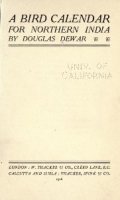Here we present the next extract from Douglas Dewar’s A Bird Calendar for Northern India, published in 1916, where the author gives a wonderful account for the month of March, with particular reference to bird migration.
| In March the climate of the plains…varies from place to place. In the western sub-Himalayan tracts, as in the Punjab, the weather still leaves little to be desired. The sun indeed is powerful…but the nights and early mornings are delightfully cool.The garden, the jungle and the forest are beautified by the gorgeous reds of the flowers of the silk-cotton tree, the Indian coral tree and the flame-of-the-forest.March is a month of great activity for the birds…The great exodus of the winter visitors from the plains of India begins…
This exodus is usually preceded by the gathering into flocks of the rose-coloured starlings*… Large noisy congregations of these birds are a striking feature of February in Bombay, of March in the United Provinces, and of April in the Punjab. Rose-coloured starlings spend most of their lives in the plains of India, going to Asia Minor for a few months each summer for nesting purposes. In the autumn they spread themselves over the greater part of Hindustan, most abundantly in the Deccan. In the third or fourth week of February the rosy starlings of Bombay begin to form flocks. These make merry among the flowers of the coral tree, which appear first in South India, and last in the Punjab. The noisy flocks journey northwards in a leisurely manner, timing their arrival at each place simultaneously with the flowering of the coral trees. They feed on the nectar provided by these flowers and those of the silk-cotton tree. Thus the rosy starlings reach Allahabad about the second week in March, and Lahore some fifteen days later. Among the earliest of the birds to forsake the plains of Hindustan are the grey-lag goose and the pintail duck… The destination of the majority of these migrants is Tibet or Siberia, but a few are satisfied with the cool slopes of the Himalayas as a summer resort in which to busy themselves with the sweet cares of nesting… Examples of these more local migrants are the grey-headed and the verditer flycatchers, the Indian bush-chat and, to some extent, the paradise flycatcher and the Indian oriole. The Indian oriole is not the only species which finds the climate of the United Provinces too severe for it in winter; the koel and the paradise flycatcher likewise desert us in the coldest months…The return of these and the other migrant species to the Punjab in March is as marked a phenomenon as is the arrival of the swallow and the cuckoo in England in spring. |
* Current name: Rosy Starling.
Taken, with grateful thanks, from Project Gutenberg.



